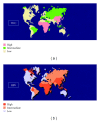Hepatocellular carcinoma: focus on different aspects of management
- PMID: 22655206
- PMCID: PMC3359687
- DOI: 10.5402/2012/421673
Hepatocellular carcinoma: focus on different aspects of management
Abstract
Hepatocellular carcinoma (HCC) is the fifth most common cancer and the third cause of cancer-related mortality worldwide. Its incidence is clearly arising comprised by the prevalence of major risk factors mainly hepatitis B and hepatitis C. The population at risk is composed of chronic liver patients at the stage of extensive fibrosis or cirrhosis. The monitoring programs of this population have allowed early detection of disease management to promote a radical therapy. Understanding the carcinogenic process and the mastery of the staging systems remain essential keys in diagnosis and treatment of HCC. Recent advances in diagnosis and new treatments have made important impacts on the disease by increasing survival rates and improving quality of life for HCC patients. This paper outlines the different management aspects of HCC which include epidemiology, prevention, carcinogenesis, staging systems, diagnosis, surveillance, and the treatment.
Figures


References
-
- McGlynn KA, London WT. Epidemiology and natural history of hepatocellular carcinoma. Best Practice and Research. 2005;19(1):3–23. - PubMed
-
- Mazzanti R, Gramantieri L, Bolondi L. Hepatocellular carcinoma: epidemiology and clinical aspects. Molecular Aspects of Medicine. 2008;29(1-2):130–143. - PubMed
-
- Shariff MIF, Cox IJ, Gomaa AI, Khan SA, Gedroyc W, Taylor-Robinson SD. Hepatocellular carcinoma: current trends in worldwide epidemiology, risk factors, diagnosis and therapeutics. Expert Review of Gastroenterology and Hepatology. 2009;3(4):353–367. - PubMed
LinkOut - more resources
Full Text Sources

